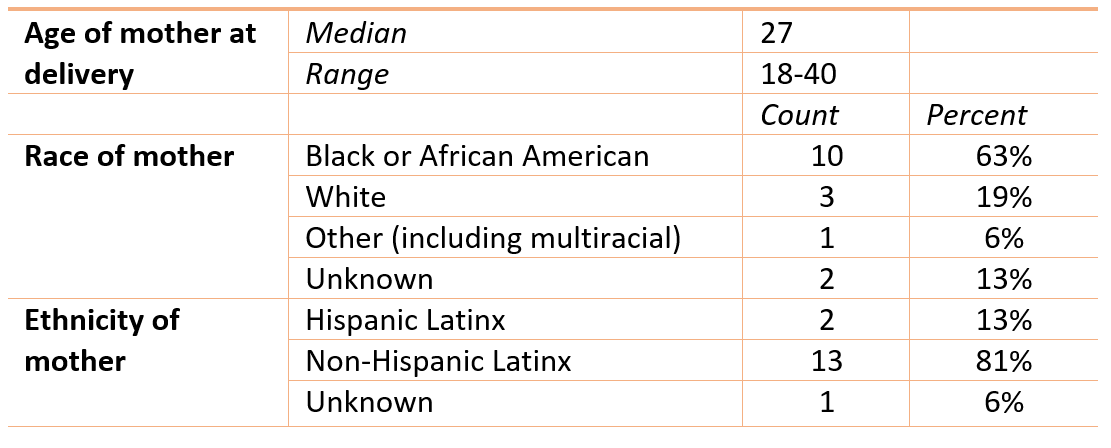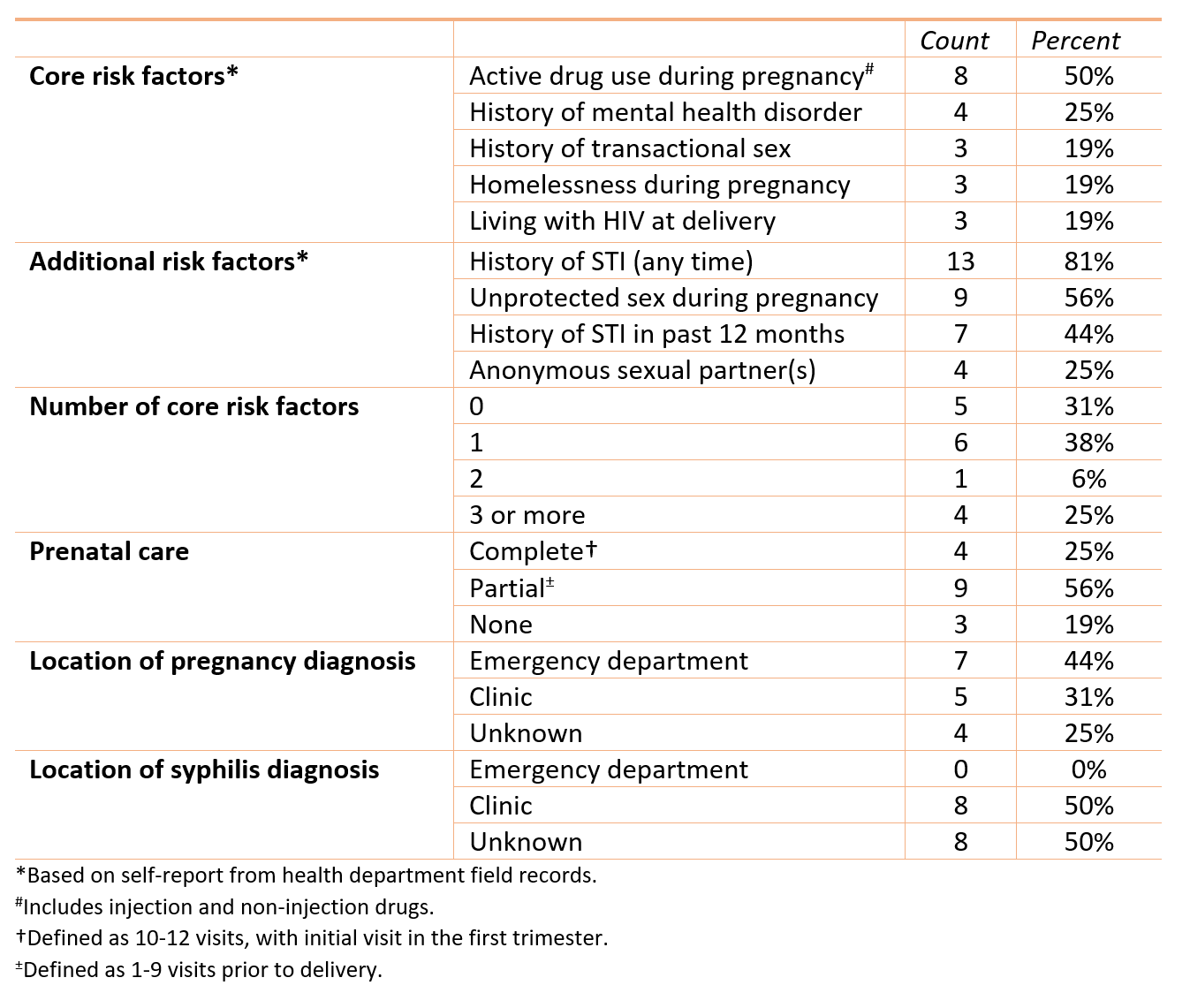Public Health & Prevention
Category: Abstract Submission
Public Health & Prevention I
564 - Congenital Syphilis in Baltimore City: An 18-Month Case Review Assessing Risk Factors and Opportunities for Prevention
Saturday, April 23, 2022
3:30 PM - 6:00 PM US MT
Poster Number: 564
Publication Number: 564.240
Publication Number: 564.240
Nicole Campion Dialo, Johns Hopkins University School of Medicine, Baltimore, MD, United States; Adena Greenbaum, Baltimore City Health Department, Baltimore, MD, United States; LaNisha Childs, Baltimore City Health Department, Baltimore, MD, United States; Ravikiran Muvva, Baltimore City Health Department, Baltimore, MD, United States; Sarah Rives, Johns Hopkins University School of Medicine, Baltimore, MD, United States; Elisabeth P. Liebow, Maryland Department of Health, Baltimore, MD, United States; Jeanne S. Sheffield, Johns Hopkins Medicine, Baltimore, MD, United States; William C. Golden, Johns Hopkins University School of Medicine, Baltimore, MD, United States; Matthew M. Hamill, Johns Hopkins SOM, Baltimore, MD, United States

William C. Golden, MD (he/him/his)
Associate Professor of Pediatrics
Johns Hopkins University School of Medicine
Baltimore, Maryland, United States
Presenting Author(s)
Background: From 2015 to 2019, rates of congenital syphilis (CS) in the United States increased by 291%. Over a similar period in Baltimore City, CS rates were 2 to 8 times higher than national rates, reminiscent of the disparity seen during the city's 1996-1997 CS epidemic. CS is preventable by testing and treating pregnant people and their partners and addressing risk factors for syphilis infection. However, barriers to maternal diagnosis and treatment remain.
Objective: To identify risk factors for CS and barriers to syphilis diagnosis and treatment in pregnant people in Baltimore City.
Design/Methods: Between January, 2020 and June, 2021, we identified people with a CS pregnancy using Baltimore City Health Department field records. Electronic medical records (EMRs) from the State of Maryland Designated Health Information Exchange were reviewed for data for each pregnancy leading to the incident CS case (as well as prior to the pregnancy, if available). Risk factors for CS (based on self-report and EMR review) were identified, and descriptive analysis of barriers to treatment were performed.
Results: We reviewed maternal records from 16 CS cases, including 1 stillbirth. The median maternal age was 27 years (range 18-40), and 10 women (63%) were identified as Black/African American (Table 1). Eleven (69%) had one or more core risk factors for CS, including active drug use, history of transactional sex, or mental illness. Twelve (75%) received incomplete or no prenatal care (Table 2). Barriers to diagnosis and/or treatment of maternal syphilis included substance abuse (44%), loss to follow-up after syphilis diagnosis (38%), late presentation to prenatal care (31%), maternal re-infection from an untreated partner (31%), and lack of availability of prenatal records in clinical EMRs (31%, Table 3). Seven women (44%) had eight encounters with the health system identified as missed opportunities for diagnosis or treatment of maternal syphilis. All infants received evaluation and necessary treatment for CS per Centers for Disease Control guidelines.Conclusion(s): Review of a contemporary population of pregnant people in Baltimore City identified multiple, persistent barriers and missed opportunities for syphilis testing and treatment in both acute and non-acute health care settings. Further investigation is needed to develop a coordinated approach for utilizing clinical and non-clinical settings to diagnose and treat people with syphilis and prevent CS. Methods facilitating data exchange by medical systems, such as EMR linkage, also should be considered.
Table 1. Demographics (n=16)
Table 2. Congenital Syphilis Risk Factors and Prenatal Care History (n=16)
Objective: To identify risk factors for CS and barriers to syphilis diagnosis and treatment in pregnant people in Baltimore City.
Design/Methods: Between January, 2020 and June, 2021, we identified people with a CS pregnancy using Baltimore City Health Department field records. Electronic medical records (EMRs) from the State of Maryland Designated Health Information Exchange were reviewed for data for each pregnancy leading to the incident CS case (as well as prior to the pregnancy, if available). Risk factors for CS (based on self-report and EMR review) were identified, and descriptive analysis of barriers to treatment were performed.
Results: We reviewed maternal records from 16 CS cases, including 1 stillbirth. The median maternal age was 27 years (range 18-40), and 10 women (63%) were identified as Black/African American (Table 1). Eleven (69%) had one or more core risk factors for CS, including active drug use, history of transactional sex, or mental illness. Twelve (75%) received incomplete or no prenatal care (Table 2). Barriers to diagnosis and/or treatment of maternal syphilis included substance abuse (44%), loss to follow-up after syphilis diagnosis (38%), late presentation to prenatal care (31%), maternal re-infection from an untreated partner (31%), and lack of availability of prenatal records in clinical EMRs (31%, Table 3). Seven women (44%) had eight encounters with the health system identified as missed opportunities for diagnosis or treatment of maternal syphilis. All infants received evaluation and necessary treatment for CS per Centers for Disease Control guidelines.Conclusion(s): Review of a contemporary population of pregnant people in Baltimore City identified multiple, persistent barriers and missed opportunities for syphilis testing and treatment in both acute and non-acute health care settings. Further investigation is needed to develop a coordinated approach for utilizing clinical and non-clinical settings to diagnose and treat people with syphilis and prevent CS. Methods facilitating data exchange by medical systems, such as EMR linkage, also should be considered.
Table 1. Demographics (n=16)

Table 2. Congenital Syphilis Risk Factors and Prenatal Care History (n=16)

